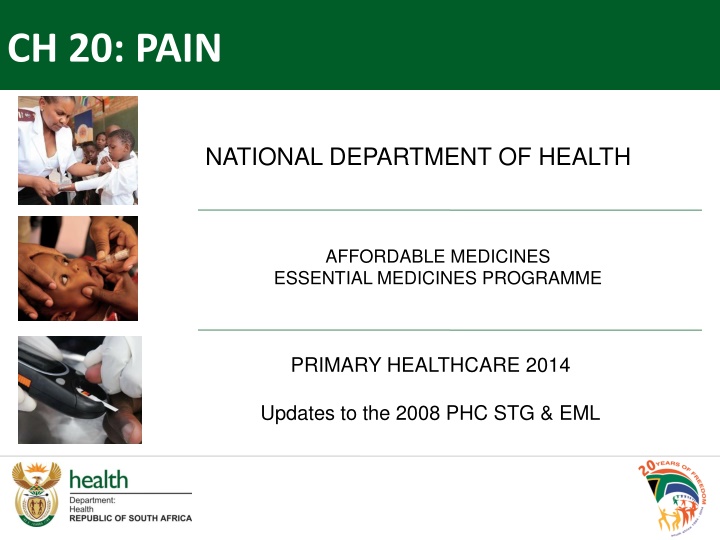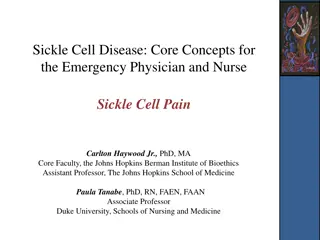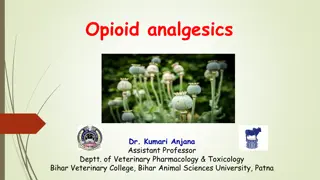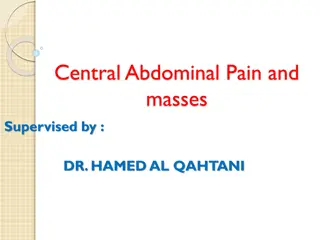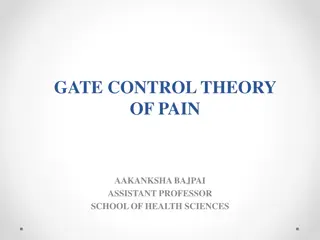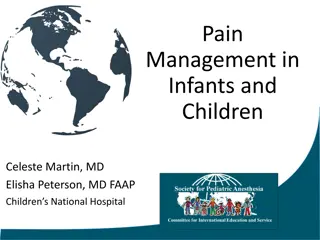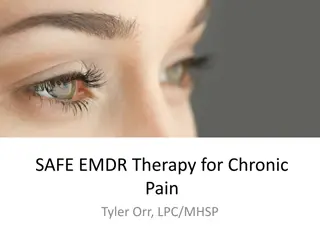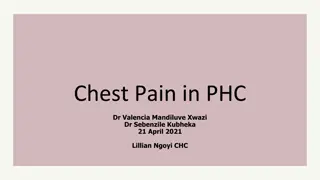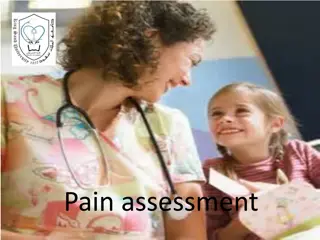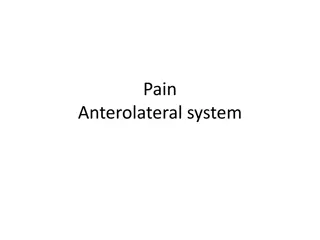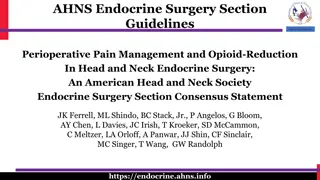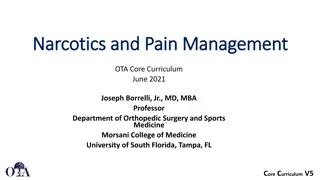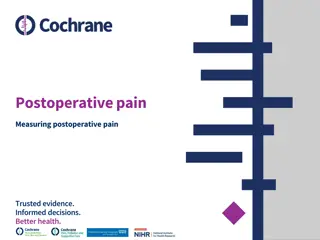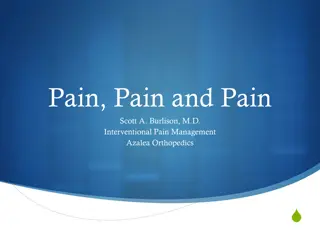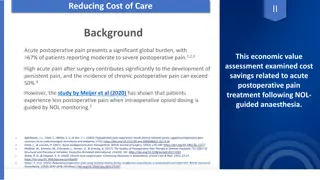Update on Pain Management in Primary Healthcare
The updates to the 2014 Primary Healthcare Implementation Slides focus on pain control for children, including the addition of ibuprofen and exclusion of tramadol for moderate pain. The management of acute severe pain involves retaining morphine injection while omitting metocloperamide, paracetamol, and tramadol IV due to practical concerns. In chronic non-cancer pain, morphine slow-release tablets are added, but oxycodone slow-release tablets/capsules are not included due to potential interactions. Mist morphine is recommended for breakthrough pain in children. The use of adjuvant therapies like amitriptyline and methadone is discussed for adults, with restrictions on prescribing amitriptyline due to safety concerns.
Download Presentation

Please find below an Image/Link to download the presentation.
The content on the website is provided AS IS for your information and personal use only. It may not be sold, licensed, or shared on other websites without obtaining consent from the author.If you encounter any issues during the download, it is possible that the publisher has removed the file from their server.
You are allowed to download the files provided on this website for personal or commercial use, subject to the condition that they are used lawfully. All files are the property of their respective owners.
The content on the website is provided AS IS for your information and personal use only. It may not be sold, licensed, or shared on other websites without obtaining consent from the author.
E N D
Presentation Transcript
CH 20: PAIN NATIONAL DEPARTMENT OF HEALTH AFFORDABLE MEDICINES ESSENTIAL MEDICINES PROGRAMME PRIMARY HEALTHCARE 2014 Updates to the 2008 PHC STG & EML
20.1 PAIN CONTROL MODERATE PAIN Children: Ibuprofen: added Aligned with Paediatric Hospital level STG, 2013. Tramadol: not added Not pragmatic for primary level of care for management of moderate pain in children. Level of Evidence: III Guidelines Ref 1 PRIMARY HEALTHCARE IMPLEMENTATION SLIDES 2014: PAIN 2
20.1 PAIN CONTROL ACUTE SEVERE PAIN Morphine injection: retained Metocloperamide: not added Paracetamol, IV: not added Tramadol, IV: not added Impractical to use syringe drivers for subcutaneous administration of morphine for primary level of care. Not pragmatic to include paracetamol IV and tramadol IV to the PHC EML. Metocloperamide is included in the STG for concomitant significant nausea and vomiting in chronic cancer pain. Level of Evidence: III Expert opinion PRIMARY HEALTHCARE IMPLEMENTATION SLIDES 2014: PAIN 3
20.2 CHRONIC NON-CANCER PAIN Oxycodone slow release tablets/capsules: not added Morphine slow release tablets/capsules: added (Refer to the medicine review for oxycodone) Paucity of robust head-to-head comparative trials of oxycodone vs. morphine. Morphine more nausea; oxycodone more hallucinations. Oxycodone is hepatically metabolised potential drug-drug interactions. Most oxycodone studies done in patients with chronic non cancer pain. SIGN stated: Bioequivalence studies of (generic) modified release opioid preparations in the UK are unsatisfactory (e.g. comparator not available in the UK; comparator product , immediate release formulation). Studies on switching between opioids are of poor quality & often anecdotal. Management of chronic non-cancer pain for adults was delineated from children medicinal therapy. Level of Evidence: III Guidelines Ref 2 PRIMARY HEALTHCARE IMPLEMENTATION SLIDES 2014: PAIN 4
20.2 CHRONIC NON-CANCER PAIN CHILDREN Mist morphine: retained Tilidine: not added Mist morphine is required for breakthrough pain (adults) & pain management (children). PHC STG recommends administration of morphine, prior to referral to secondary level & inclusion of an additional pain medicine (tilidine) to the EML not considered pragmatic. Ref 3 Level of Evidence: III Expert opinion PRIMARY HEALTHCARE IMPLEMENTATION SLIDES 2014: PAIN 5
20.2 CHRONIC NON-CANCER PAIN ADJUVANT THERAPY ADULTS: Amitriptyline: retained Tramadolol: retained Methadone: not added Restricting prescribing of amitriptyline to specialists only, due to irrational medicine use was not considered pragmatic for primary level of care the STG restricts the medicine as doctor initiated. Concerns about the rising incidence of death from opioid overdose (report from North America) was noted. Pain requiring strong opioids require referral to secondary level of care. Tramadolol, a weak opioid, was retained in the STG. An external comment to include methadone (based on the National Cancer Institute guidelines) in the primary level EML for neuropathic pain was not pragmatic for primary level of care. Level of Evidence: III Expert opinion PRIMARY HEALTHCARE IMPLEMENTATION SLIDES 2014: PAIN 6
20.2 CHRONIC NON-CANCER PAIN CHILDREN Non-opioid Ibuprofen: amended The weight-band dosing table for ibuprofen was amended for correctness. For anxiety Diazepam, oral: retained for a maximum of 2 weeks. Lorazepam, sublingual: not added Lorazepam sublingual is not included in the PHC EML. PRIMARY HEALTHCARE IMPLEMENTATION SLIDES 2014: PAIN 7
CASE STUDY A 55 year old male patient with chronic cancer pain complains of pain between his morphine dosing. Patient indicated that there are 2 periods in the day when the morphine does not seem to be working. The patient s current prescription includes: Morphine, oral, 20mg 4 hourly Ibuprofen 400mg 6 hourly Paracetamol 1g 6 hourly What adjustments would you make to the prescription? PRIMARY HEALTHCARE 2014 IMPLEMENTATION SLIDES: EYE CONDITIONS 8
CASE STUDY: SOLUTION A doctor must adjust the dose of morphine according to the number of episodes of break through pain episodes per day. Remember there is no maximum morphine dose threshold for this indication. Adjust Morphine dose as follows: Patient gets 30 mg morphine every four hours. The patient has 2 episodes of breakthrough pain: 2x 30 mg = 60 mg 60 mg 6 = 10 mg The regular 4 hourly dose of 30 mg must be increased by 10 mg i.e. 30 mg + 10 mg = 40 mg. The increased morphine dose will be 40 mg 4 hourly. Dose of Ibuprofen can also be adjusted to a maximum dose of 2400mg (doses must be administered with food) must be doctor initiated. PRIMARY HEALTHCARE 2014 IMPLEMENTATION SLIDES: EYE CONDITIONS 9
Slide Ref # Reference 20.1 PAIN CONTROL 2 1 IBUPROFEN Paediatric Hospital level STG, 2013. 20.2 CHRONIC NON-CANCER PAIN 4 2 OXYCODONE SLOW RELEASE TABLETS/CAPSULES Scottish Intercollegiate Guidelines Network. [Internet] 106: Control of pain in adults with cancer. A national clinical guideline. [November 2008; cited February 2014]. Available at: http://www.sign.ac.uk/pdf/SIGN106.pdf National Department of Health, Affordable medicines, Essential Drugs Programme: Oxycodone medicine review. Adult Hospital level STG, 2012. 4 2 MORPHINE SLOW RELEASE TABLETS/CAPSULES Scottish Intercollegiate Guidelines Network. [Internet] 106: Control of pain in adults with cancer. A national clinical guideline. [November 2008; cited February 2014]. Available at: http://www.sign.ac.uk/pdf/SIGN106.pdf National Department of Health, Affordable medicines, Essential Drugs Programme: Oxycodone medicine review. Adult Hospital level STG, 2012. 5 3 MIST MORPHINE World Health Organisation. WHO guidelines on the pharmacological treatment of persisting pain in children with medical illnesses. 5 3 TILIDINE World Health Organisation. WHO guidelines on the pharmacological treatment of persisting pain in children with medical illnesses. 10
